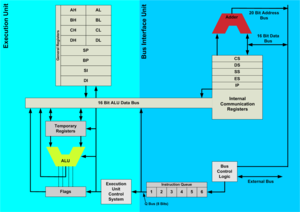Intel 80186: Difference between revisions
m cat |
No edit summary |
||
| Line 15: | Line 15: | ||
The '''80186''' is a [[microprocessor]] that was developed by [[Intel]] circa [[1982]]. The 80186 was an improvement on the [[Intel 8086]] and [[Intel 8088]]. As with the 8086, it had a [[16-bit]] external bus and was also available as the [[Intel 80188]], with an [[8-bit]] external [[data bus]]. The initial clock rate of the 80186 and 80188 was 6 [[Megahertz|MHz]], but due to more hardware (in place of [[microcode]]) some of the individual instructions ran 10-20 times faster than on an 8086 at the same clock frequency. On the average, it ran at 1 million [[instructions per second]]. [http://www.geocities.com/SiliconValley/Pines/4011/misc-doc/Intel-Chips.htm] |
The '''80186''' is a [[microprocessor]] that was developed by [[Intel]] circa [[1982]]. The 80186 was an improvement on the [[Intel 8086]] and [[Intel 8088]]. As with the 8086, it had a [[16-bit]] external bus and was also available as the [[Intel 80188]], with an [[8-bit]] external [[data bus]]. The initial clock rate of the 80186 and 80188 was 6 [[Megahertz|MHz]], but due to more hardware (in place of [[microcode]]) some of the individual instructions ran 10-20 times faster than on an 8086 at the same clock frequency. On the average, it ran at 1 million [[instructions per second]]. [http://www.geocities.com/SiliconValley/Pines/4011/misc-doc/Intel-Chips.htm] |
||
They were generally used as [[embedded processor]]s (roughly comparable to [[microcontroller]]s). They were not used in many [[personal computer]]s, but there were some notable exceptions: the [[Mindset computer|Mindset]], the [[Siemens PC-D]] ( |
They were generally used as [[embedded processor]]s (roughly comparable to [[microcontroller]]s). They were not used in many [[personal computer]]s, but there were some notable exceptions: the [[Mindset computer|Mindset]], the [[Siemens PC-D]] ([[Siemens]]' first [[DOS]] PC line, which ran [[MS-DOS]] v2.11 even though their hardware was not 100% [[IBM PC-compatible]]), the [[Compis]] (a [[Sweden|Swedish]] school computer), the [[Research Machines|RM Nimbus]] (a British school computer), the [[Unisys ICON]] (a Canadian school computer), ORB Computer by ABS, the [[HP 200lx]], the [[Tandy 2000]] desktop (a somewhat PC-compatible workstation featuring particularly sharp graphics for its day) and the Philips "Yes". Another British computer manufacturer, [[Acorn Computers|Acorn]], created a plug-in second processor that contained the 80188 chip along with assorted support chips and 512 KB of RAM – hence the Master 512 system. |
||
One major function of the 80186/80188 series was to reduce the number of chips required by including features such as a [[Direct memory access|DMA]] controller, interrupt controller, timers, and [[chip select]] logic. |
One major function of the 80186/80188 series was to reduce the number of chips required by including features such as a [[Direct memory access|DMA]] controller, interrupt controller, timers, and [[chip select]] logic. |
||
Revision as of 14:53, 11 August 2008
 An Intel 80186 Microprocessor | |
| General information | |
|---|---|
| Launched | 1982 |
| Discontinued | present (the CMOS version) |
| Common manufacturer |
|
| Performance | |
| Max. CPU clock rate | 6 MHz to 12 MHz |
| Architecture and classification | |
| Instruction set | x86-16 |
| Physical specifications | |
| Package |
|

The 80186 is a microprocessor that was developed by Intel circa 1982. The 80186 was an improvement on the Intel 8086 and Intel 8088. As with the 8086, it had a 16-bit external bus and was also available as the Intel 80188, with an 8-bit external data bus. The initial clock rate of the 80186 and 80188 was 6 MHz, but due to more hardware (in place of microcode) some of the individual instructions ran 10-20 times faster than on an 8086 at the same clock frequency. On the average, it ran at 1 million instructions per second. [1]
They were generally used as embedded processors (roughly comparable to microcontrollers). They were not used in many personal computers, but there were some notable exceptions: the Mindset, the Siemens PC-D (Siemens' first DOS PC line, which ran MS-DOS v2.11 even though their hardware was not 100% IBM PC-compatible), the Compis (a Swedish school computer), the RM Nimbus (a British school computer), the Unisys ICON (a Canadian school computer), ORB Computer by ABS, the HP 200lx, the Tandy 2000 desktop (a somewhat PC-compatible workstation featuring particularly sharp graphics for its day) and the Philips "Yes". Another British computer manufacturer, Acorn, created a plug-in second processor that contained the 80188 chip along with assorted support chips and 512 KB of RAM – hence the Master 512 system.
One major function of the 80186/80188 series was to reduce the number of chips required by including features such as a DMA controller, interrupt controller, timers, and chip select logic.
New instructions were introduced as follows:
ENTER Make stack frame for procedure parameters LEAVE High-level procedure exit PUSHA Push all general registers POPA Pop all general registers BOUND Check array index against bounds UD2 Generate invalid opcode exception INS Input from port to string OUTS Output string to port
External links
- Intel's Official Page for the 80186
- Intel 80186/80188 images and descriptions at cpu-collection.de
- Scan of the Intel 80186 data book at datasheetarchive.com
- Intel Microprocessor History
This article is based on material taken from the Free On-line Dictionary of Computing prior to 1 November 2008 and incorporated under the "relicensing" terms of the GFDL, version 1.3 or later.
